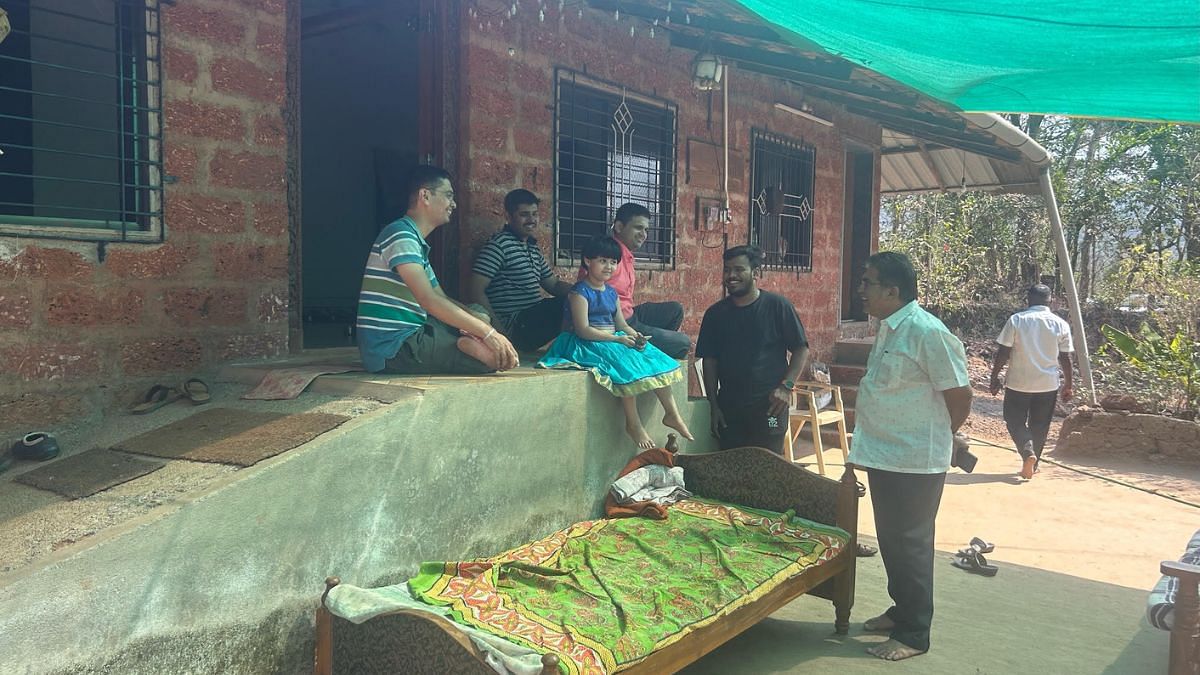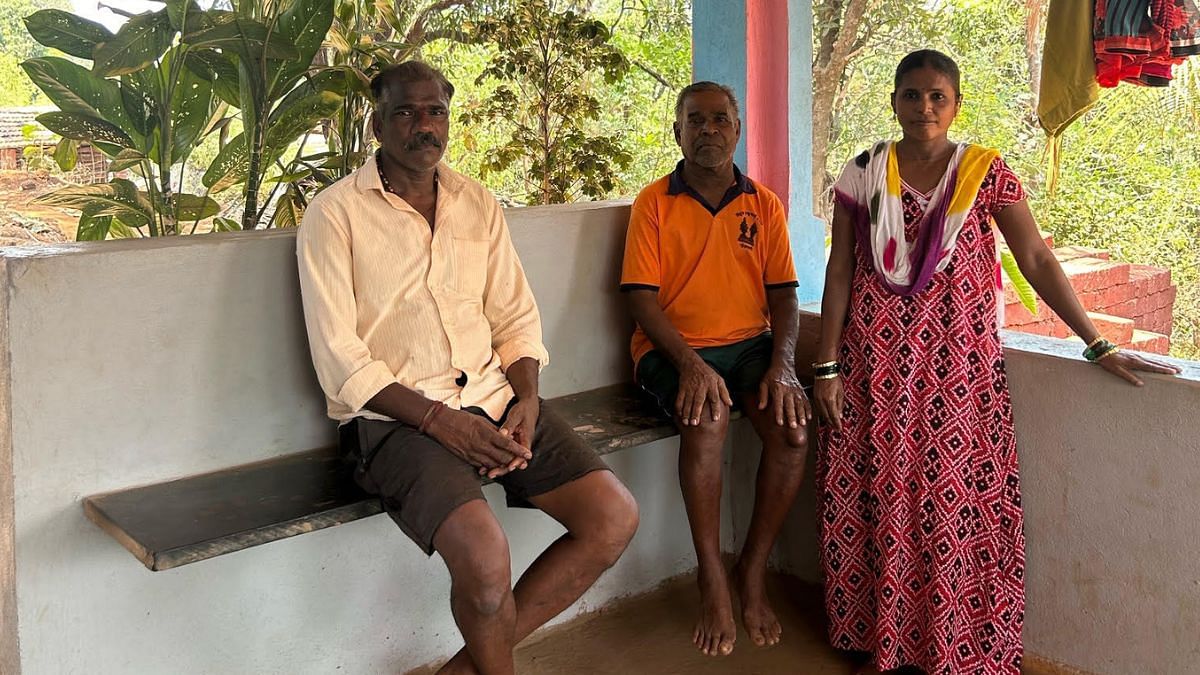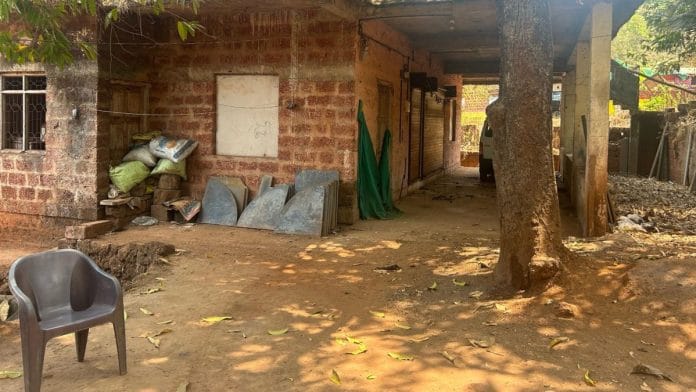Ratnagiri: Nestled along the coastal stretch of Maharashtra’s Konkan region, Ratnagiri is known for its scenic beaches, delectable seafood, picturesque Sahyadris, the cool kokum and nectarine Alphonso mangoes. However, a lesser-known facet of the destination is its deserted, white-haired villages that are stuck in time.
Sunil Salunke’s village, Satavali in the Lanja taluka of Ratnagiri district, got a cellular phone network for the first time about a year ago.
“That was when I realised that my life had hit pause. The rest of the world had moved 40-50 years ahead,” said Salunke, a blacksmith, sitting outside his house next to an unlit smelter, while his wife lounged inside consuming content on her mobile phone.
Salunke patiently bided his time, waiting in the village for a cellphone network, just like he has been for some small and medium-sized businesses to come up around his village, which might increase the demand for his skill.
He stayed because he didn’t have the monetary means to leave, but several others who could, chose to move on with the world over the years — leaving a string of empty houses in the village, whose locks open only on major festivals, such as Ganesh Chaturthi.
Satavali is a small hamlet of 421 households. Of these, about a hundred remain closed as the villagers have relocated entirely to urban centres like Mumbai or Pune — leaving behind the countryside in search of better job prospects, educational facilities, and entertainment options that were severely lacking.
This is the reality for one village after another in Ratnagiri, where ‘vikas (development)’ has only ever been a debate over whether or not to open doors for mega projects, such as a copper smelter by Sesa Sterlite, a power project at Dabhol in the 1990s, more recently a nuclear power project at Jaitapur, and now an oil refinery at Barsu-Dhopeshwar.
According to proponents, these big-ticket industries will bring the much-needed jobs, while detractors claim, they will come at a huge environmental cost and the jobs will only go to migrants, not residents.
Amid this, about 25 percent of the houses in any given village, according to estimates by residents, are shut and the population left behind is all white-haired, senior citizens who have been surviving on the little money their children send home from the cities.
The roads leading to many of these hamlets are non-existent, though Ratnagiri residents admit that connectivity has generally improved over the past decade.
Moreover, unlike Satavali, several villages still don’t have any mobile phone connectivity in a world where cellular data is increasingly being seen as an essential aspect of modern existence.
As the district heads to the polls as part of the larger Ratnagiri-Sindhudurg Lok Sabha constituency on 7 May, its ‘vikas’ has again become a buzzword being tossed around by the two key candidates — Vinayak Raut of the Shiv Sena (Uddhav Balasaheb Thackeray) and Narayan Rane of the Bharatiya Janata Party (BJP).
With both sides taking credit for whatever little development is seen in the district — the improved road network and the few villages with newfound cell phone connectivity — many think it’s going to take some real and well-intentioned political will for things to change.
“Elections will come and go, but it seems like we will continue to live like this till the end of time — cut off from the world with monkeys swaying from branches to the rooftops of the empty houses of our village,” said 41-year-old Amol Lingaye, who lives in the Dhopeshwar village in the Rajapur taluka, very close to the proposed site for the contentious integrated refinery and petrochemicals project.

Lingaye is among the few his age to stay back in his village as his family has been performing priesthood duties for the Dhopeshwar temple in his village. “Moreover, our mango plantations are shrinking due to increasing labour costs and environmental changes that are making it more and more difficult to reap a good harvest,” he added.
Also Read: Ajit Pawar’s NCP on BJP’s side, but here’s what makes western Maharashtra tough to breach
‘Money order economy’
Migration of the youth from the villages of Ratnagiri and, to a certain extent, Sindhudurg, to Mumbai is hardly new. These youngsters work in the cities, taking up whatever jobs they are qualified for — from drivers and nannies to corporate managers and professionals — remitting a part of their salaries back home for their parents to survive.
This earned the coastal region the moniker of a “money order economy”.
This “money order economy” is also why the undivided Shiv Sena under founder Bal Thackeray grew strong in the Konkan districts. Sena’s fight for employment for the local Maharashtrian in Mumbai, its ’sons of the soil’ agenda with which the party was born in 1966, directly benefited the Konkani migrant, and outside of Mumbai, the party found roots in parts of Raigad, Ratnagiri and Sindhudurg districts as well.
Narayan Rane started his career with the Shiv Sena, spending more than three decades with the party and developing Sindhudurg, his home turf, as his political bastion.
In 2005, he left for the Congress and in 2017, formed his party and aligned with the National Democratic Alliance (NDA), before merging his party with the BJP — taking his political stock from party to party.
The Shiv Sena split and politicians changed party lines, but the established system of migration from Ratnagiri remained.
“Not much changed, so people got used to the money order economy. And because people got used to this, not much changed,” said Vinay Natu, a former BJP MLA from Guhagar in Ratnagiri.

Natu was sitting under a canopy of trees in his home village, Makhajan, after a heavy traditional lunch of shrikhand and puri. The ‘Brahmanwadi’ of the village was celebrating Hanuman Jayanti for which everyone from the settlement comes home from cities, such as Mumbai and Pune, to celebrate as a community.
“Celebrations typically used to go on for five days. But this year, we cut it to three days because the younger generation finds it difficult to come back for that long,” said Madhusudan Ranade, a sexagenarian who had come back to Makhajan for it from Pune.
Need for ‘booster dose’
Last Wednesday, Keshav Dugad, who introduced himself as a retired official of the Maharashtra Industrial Development Corporation (MIDC), spoke to a roomful of people about how clusters of mango and cashew production in the district are lacklustre and need a “booster dose” from the government.
“The way the state government has supported sugar and milk industries in Maharashtra, we need to support clusters of small and medium enterprises for mangoes and cashews,” Dugad said, addressing a “buddhijeevi melava,” a gathering of intellectuals — lawyers, doctors, chartered accountants, teachers, engineers and so on — from Ratnagiri district.
He added that despite the region’s potential, “we are importing a significant part of our cashew requirement today from Africa”.
The gathering was a part of Rane’s campaign and the leader was seated on stage, just a few paces away from where Dugad was speaking.
“Dada,” Dugad said, addressing Rane, “You are a minister at the Centre, Uday Samant ji is a minister in the state. If both of you decide, it can definitely happen.”
Rane is currently the Union Minister for Micro, Small and Medium Enterprises in the Narendra Modi-led Union Cabinet, while Samant, a leader from the Shinde-led Shiv Sena, is the state industries minister and the guardian minister for Ratnagiri district.
Samant’s brother Kiran was also on the stage seated next to Rane.
Responding to Dugad on the stage, Rane said he had helped establish many industrial clusters in the Ratnagiri-Sindhudurg belt when he was the state industries minister, “but outsiders came to work here”.
“Children who have studied here are looking for jobs, but we don’t have any Marathi industrialists. That will be one of my priorities,” Rane said at the gathering.
Later, speaking to ThePrint, Rane admitted that the Ratnagiri district has lagged in industrialisation and development.
“It is true that the roads are not good. I will tell people, give me 2.5 to 3 years. I will create basic infrastructure in all villages — roads, water, electricity, schools, colleges, medical and engineering colleges… I will create industries in this district, micro, small and medium. But all these industries should be led by local youth and they will be given help in every way. We will create local entrepreneurs who can create job opportunities,” he assured.
According to the latest state Economic Survey report, in 2021-22 the Ratnagiri district, spread across 8,326 square km, reported a real Gross Democratic Product (GDP) of Rs 24,855 crore — making it one of the 15 laggard districts of the state.
This is despite its geographical proximity to industrial powerhouses, such as Mumbai, Pune, Thane, and Nashik.
Dugad, like a few others from the district, was supportive of getting the contentious Barsu oil refinery — a project called Ratnagiri Refinery & Petrochemicals Ltd that will be jointly developed by a consortium of Indian oil marketing companies — to his district saying it will create jobs.
Rane, too, has voiced his emphatic support for the project in the past but is treading carefully closer to elections.
Speaking to ThePrint last month, he said he would discuss the project with people and then do as they want. The caution in his words now is perhaps because the project, which sparked unrest in Ratnagiri exactly a year ago, remains a highly divisive subject.
The refinery’s detractors fear exactly what Rane said has happened to every significant industry that has come to the district so far. The jobs will go to migrants, who may work more for cheaper.
“Our people don’t want to work as daily labour, neither in factories nor in agriculture. There is a certain aspiration because of which they seek the cities. We need small businesses related to agro-processing, horticultural products, storage and preservation, and tourism,” Shiv Sena (UBT)’s Vinayak Raut, two-time MP from the Ratnagiri-Sindhudurg constituency and Rane’s opponent, told ThePrint.
To Raut’s point, even the labourers who toil in the mango orchards of Ratnagiri and Sindhudurg, and help produce the famous Alphonso are not residents, but over one lakh farm workers are from Nepal.
Also Read: Old adversary now both a friend & a foe — Narayan Rane’s comeback & his tryst with the 2 Shiv Senas
No work, no play
Riddhi Ghume grew up in the Machal village, up on the Sahyadris, studying in the village school, which offers education till Class XII.
Following that, she had three choices: embark on a daily four-hour round-trip hike to catch a bus for higher education at the taluka headquarters, leave school to pick up an odd job close to the village, or drop out of school and relocate to Mumbai in search of work.
The first option was out of the question. For the second, the only work available close to her house was in neighbouring Vishalgad where there is a famous dargah, which draws a lot of visitors.
“Machal to Vishalgad is a one-hour walk. There are a few shops and lodges there that employ people from neighbouring villages to walk up and down to the nearest water source and ferry large cartons of water. At the end of the day, the payment 10 years ago was Rs 50 for our labour. It wasn’t worth it, so in 2014, I came to Mumbai where my uncle had already settled. Since then, I have been working as a nanny in homes of busy parents,” said Ghume, who goes home once a year to see her parents.
Machal is known as the “Mahabaleshwar of Ratnagiri” for its cooler climate and stunning views from hilltops and has been getting a trickle of trekkers on and off.
Last year, the village got a motorable road for the first time, Ghume said, and the number of visitors has marginally increased since. “If planned well as a tourist destination, our people will get a lot of employment,” she told ThePrint.
While Ghume couldn’t complete her education, in Satavli, Iram Barmare and her siblings are overqualified for the region.

Barmare’s brother is an engineer and moved out to be in the merchant navy. Her younger sister is preparing to move out of Ratnagiri this year to study pharmacy.
Unlike her siblings and her friends who have moved out, Barmare chose a different path after graduation. She became Satavli’s sarpanch. “I wanted to ensure we get development funds for our village,” she told ThePrint.
Meanwhile, in nearby Golavshi village, the day is an endless wait for 75-year-old Ramchandra Veer and 61-year-old Santosh Veer, both friends and neighbours.

Ramchandra’s son is in Nalasopara, a settlement in the extended Mumbai Metropolitan Region, “working as a manager in an office”. Santosh’s son is in Kandivali, a Mumbai suburb, “working as a driver with a good family”.
The Veer friends finish their daily chores and then just sit around, reposed, idle in the quietness of their village. There is a small television set, but it doesn’t hold their attention beyond a point. Cell phones don’t work here.
As the leaves rustle in the breeze and the Sun starts to go down, they head back home, have dinner and sleep. Come the next day, it’s rinse and repeat.
(Edited by Richa Mishra)
Also Read: From Dabhol to Barsu, why industrial politics dogs projects in Maharashtra’s Ratnagiri






